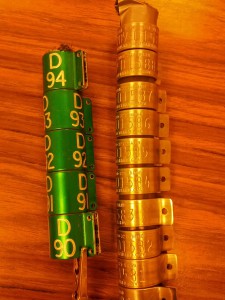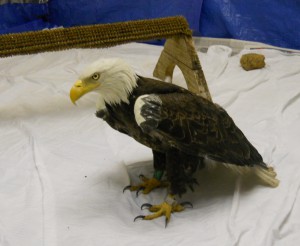Green Bands: Telling the Story of New Jersey Eagles
January 2015 is the Month of the Eagle! CWF is kicking off the new year by celebrating all things eagle. Follow us on social media and be sure to check your email (sign up for our list) for weekly stories on these amazing raptors from our own eagle biologist Larissa Smith. Larissa, a wildlife biologist who has been working for Conserve Wildlife Foundation since 2000, coordinates the New Jersey Bald Eagle Monitoring Project.
By: Larissa Smith, Wildlife Biologist and Volunteer Manager
During the Month of the Eagle, we have discussed at length the use of telemetry to see the daily movements of eagles in the state. Another method that biologists use to obtain information on New Jersey eagles is from Re-Sighting New Jersey Eagles. Biologists look for the bands on the re-sighted eagles to find out the age of the bird and the nest that it came from.
In June 2014, we learned about a banded New Jersey Eagle Nesting in PA. Unfortunately, the pair lost its chicks during a wind storm last April. I recently contacted Linda Oughton, the nest observer, and she reports that the pair has been busy bringing sticks to the nest in preparation for the upcoming nesting season. We wish “Jersey Girl” and her mate a successful year!

Biologists also obtain information about New Jersey eagles from bands when eagles are recovered injured or dead. This isn’t as “feel good” as the re-sighting of a living, healthy bird, but the band still contains valuable information about the eagle’s age and the nest from which it originated.
If you find a bird with a New Jersey band, please report it to the National Bird Banding Lab.
The Banding Lab notifies New Jersey biologists when a band has been reported. The majority of recovered New Jersey birds are found in our state, but Jersey banded eagles have also been recovered in Delaware, Maryland, New York, Pennsylvania and Maine. Each band that is found tells a story about the eagles life.
- On April, 26, 2013, a female eagle was found dead at the Aberdeen Proving Ground in Maryland. She was banded with a red band which revealed that she was one of the eagles from the Dividing Creek Hack site* in 1988, making her 25 years old when she died. The nest observer at the Aberdeen believes that this was the female she observed nesting at Aberdeen for 20 years. At the time of the eagle’s death, there were three chicks in the nest and the male was able to successfully raise them by himself. She is the oldest New Jersey banded eagle that has been recovered.
- In the fall of 2013, the remains of an eagle with a red band were found in the Nantuxent Wildlife Management Area. The bird was 24 years old. The eagle had been brought along with another eaglet from Canada after their nest was lost. They were placed in the Tuckahoe Hack site* and fledged in 1989.
*The New Jersey eagle hacking project was started in 1983 as a part of the eagle restoration efforts. Young eagles approximately six weeks of age were brought from Canada where the eagle population was stable. Hacking towers were built at two sites, Dividing Creek, Cumberland County and Tuckahoe, Cape May County. The chicks were placed in the towers and provided food until the time of fledging. The idea was that the birds, when mature, would return to their place of fledging to nest. These hacked eagles were banded with a red band. Sixty young birds were fledged from these hacking towers over an eight year period contributing to the increase in the New Jersey eagle population.
- A thirteen year old eagle was recovered in November of 2011 in Delaware, the cause of death was determined to be lead poisoning. The bird had been banded on May 14, 1999 in Cumberland County. What makes this eagle so special is that in 2003 the same bird was found in Cape May County with a leg hold trap attached to its foot. The foot was amputated and the bird was released. It is amazing to know that this eagle survived for eight years with just one foot!
- The Duke Farms Eagle Cam is has gained a large online following, so it was sad news when one of the juveniles from the 2014 nest was found dead in Maine this past August. From talking with the finders of the bird we were able to piece together the story of D-98.
These are just a few examples of the recoveries of dead eagles, but there are also many injured eagles that are cared for by dedicated wildlife rehabilitators and released back into the wild.

A New Jersey banded eagle was rescued from the Chesapeake Bay by a fisherman from Cecil County, Maryland on March 17th, 2013. The male had been banded at the Union Lake nest, Cumberland County on May 15, 2007 making him six years old.
The eagle was taken to Tri-State Bird Rescue and Research in Delaware where he recovered from his injuries, believe to be from a territorial dispute with another eagle, and was released on May 6, 2013.
All eagle recoveries are listed in each years annual eagle report.
Learn more:
- Conserve Wildlife Foundation’s Bald Eagle Project
- Read Conserve Wildlife Foundation’s 2014 Bald Eagle Project Report